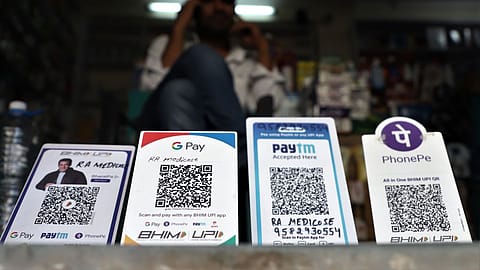India's payments system undergoing a structural shift towards a hybrid model: CareEdge Advisory report
UPI transactions have registered a phenomenal 49% CAGR between FY23 and FY25, underscoring rapid adoption with rising internet penetration as well as deepening penetration in Tier II and III cities

The share of digital transactions in private final consumption expenditure (PFCE) has grown from 30% in FY23 to 50% in Q1FY26, driven by UPI adoption, policy adjustments, and changing consumer behaviour, according to CareEdge Advisory. Despite this increase, cash remains strong, holding a 50% share in PFCE.
It notes that India's payments system is shifting towards a hybrid model, where digital and cash channels coexist, serving distinct but complementary roles. Supported by a favourable regulatory environment and innovations that improve interoperability, UPI is well-placed to strengthen its role as the core of India’s payments landscape, boosting transactional efficiency and broader economic participation.
“From a 70% share of cash usage in PFCE in FY23 to 50% in Q1FY26, India has been witnessing a payments system revolution, where cash and digital transactions will co-exist to drive financial inclusion and foster a truly inclusive economy,” said Kalpesh Mantri, assistant director at CareEdge Research.
According to the report, retail payments are now 99.8% digital, with paper-based instruments (cheques) nearly obsolete, owing to policy push, infrastructure support, and deep fintech penetration. Digital payments, led by UPI, AePS, IMPS, and others, dominate retail transactions, accounting for 92.6% of payment value and 99.8% of transaction volume as of Q1FY26. It highlights that rising internet penetration (from 60.7% in Mar’21 to 70.9% in June 2025) and smartphone usage have accelerated this shift, enabling financial inclusion by bringing previously unbanked populations into the formal digital economy.
CareEdge Advisory report highlights that UPI is the driving force behind the behavioural shift of growing digital transactions, with 54.9 billion transactions in Q1FY26 and 185.9 billion transactions in FY25. UPI transactions grew at a CAGR of 49% between FY23 and FY25, underscoring rapid adoption and deepening penetration in Tier II and III cities.
UPI is expected to continue its rapid growth, further solidifying its dominance in India’s digital payments landscape. Widespread smartphone and internet access (around 85% in 2028), combined with supportive policies and wider usage, will expand both merchant and consumer adoption.
“UPI transactions have registered a phenomenal 49% CAGR between FY23 and FY25, underscoring rapid adoption with rising internet penetration as well as deepening penetration in Tier II and III cities. However, its zero-MDR framework challenges long-term sustainability. The next growth phase will hinge on smart monetisation through value-added services like micro-credit, merchant analytics, insurance, and fintech partnerships, ensuring UPI remains both accessible and economically self-sufficient,” said Tanvi Shah, senior director at CareEdge Research.
Recommended Stories
The report also notes that NEFT remains crucial for mid-to-high-value transactions, with an average ticket size of approximately ₹48,000 as of Q1FY26, which is significantly higher than that of UPI. IMPS continues to experience steady growth but is being cannibalised by UPI, which offers a similar instant payment experience with broader merchant acceptance. While, NACH transactions remain important for bulk disbursements, such as salaries, subsidies, and dividends.